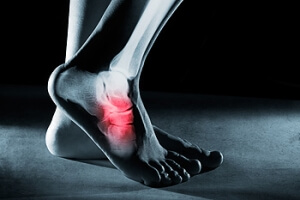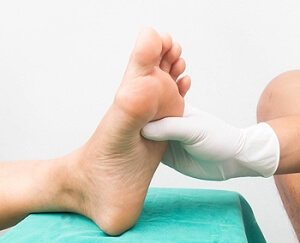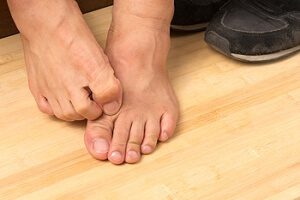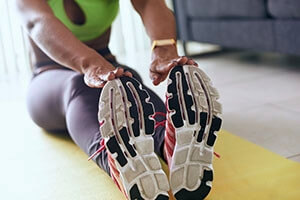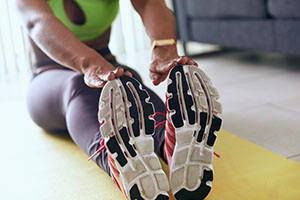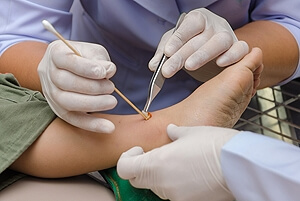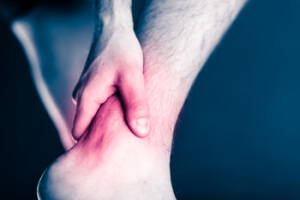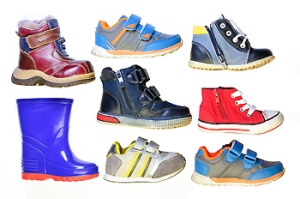Super User
Foot Surgery May Be Necessary for Permanent Relief
 There are several types of foot conditions that may require surgery for permanent relief. Bunions, hammertoes, and ingrown toenails are a few examples. A bunion is a bony protrusion on the side of the big toe, and can be quite painful. Surgery can be performed to remove this deformity and help relieve the pain. Hammertoe is a common foot condition that causes the toe to bend downward at the middle joint. Surgery can be performed to correct the joint and straighten out the toe. An ingrown toenail occurs when the nail grows into the outer edge of the skin, and this can cause severe pain and discomfort. In severe cases, surgery may be necessary to remove the affected portion of the nail. If you are considering any type of foot surgery, it is strongly recommended that you speak with a podiatrist who can help you to determine if this is the correct choice for you.
There are several types of foot conditions that may require surgery for permanent relief. Bunions, hammertoes, and ingrown toenails are a few examples. A bunion is a bony protrusion on the side of the big toe, and can be quite painful. Surgery can be performed to remove this deformity and help relieve the pain. Hammertoe is a common foot condition that causes the toe to bend downward at the middle joint. Surgery can be performed to correct the joint and straighten out the toe. An ingrown toenail occurs when the nail grows into the outer edge of the skin, and this can cause severe pain and discomfort. In severe cases, surgery may be necessary to remove the affected portion of the nail. If you are considering any type of foot surgery, it is strongly recommended that you speak with a podiatrist who can help you to determine if this is the correct choice for you.
Foot surgery is sometimes necessary to treat a foot ailment. To learn more, contact one of our podiatrists of New Tampa Foot & Ankle. Our doctors will assist you with all of your foot and ankle needs.
When Is Surgery Necessary?
Foot and ankle surgery is generally reserved for cases in which less invasive, conservative procedures have failed to alleviate the problem. Some of the cases in which surgery may be necessary include:
- Removing foot deformities like bunions and bone spurs
- Severe arthritis that has caused bone issues
- Cosmetic reconstruction
What Types of Surgery Are There?
The type of surgery you receive will depend on the nature of the problem you have. Some of the possible surgeries include:
- Bunionectomy for painful bunions
- Surgical fusion for realignment of bones
- Neuropathy decompression surgery to treat nerve damage
Benefits of Surgery
Although surgery is usually a last resort, it can provide more complete pain relief compared to non-surgical methods and may allow you to finally resume full activity.
Surgical techniques have also become increasingly sophisticated. Techniques like endoscopic surgery allow for smaller incisions and faster recovery times.
If you have any questions please feel free to contact our office located in Wesley Chapel, FL . We offer the newest diagnostic and treatment technologies for all your foot and ankle needs.
Foot and Ankle Surgery
When conservative, noninvasive methods prove ineffective, surgery may be selected as the next course of action for the treatment of your foot or ankle condition. A wide number of foot and ankle surgical procedures exist, and it is up to your podiatrist to determine which intervention will be most appropriate and helpful for your case. Some surgical procedures include bunion surgery, fusion, hammertoe surgery, heel spur surgery, metatarsal surgery, nail surgery, neuroma surgery, reconstructive surgery, skin surgery, and tendon surgery. Typically, surgery is turned to as a definitive way to alleviate excessive pain or discomfort and to return your foot to full mobility.
Regardless of the location on the body, all surgical procedures require preoperative testing and examination to ensure the surgery’s success and preferred outcome. A review of your medical history and medical conditions will take place, as will an evaluation of any current diseases, illnesses, allergies, and medications. Tests such as blood studies, urinalyses, EKG, X-rays, and blood flow studies may be ordered. Because the procedure involves the foot and/or ankle, the structures of your feet while walking may also be observed by your podiatrist.
Care post-surgery will depend on the type of surgical procedure performed. Typically, all postoperative care involves rest, ice, compression, and elevation. To improve and ensure a safe recovery, your foot and ankle surgeon may also employ the use of bandages, splints, surgical shoes, casts, crutches, or canes. He will also determine if and when you can bear weight. A timely and thorough recovery is a priority for both you and your podiatrist, and carefully following postoperative instructions can help achieve this.
What’s Causing My Lateral Foot Pain?
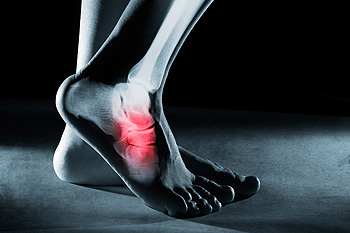 Pain felt on the outer side of the foot, or lateral foot pain, is often indicative of the condition known as cuboid syndrome. Trauma to the foot, or gradual repetitive force can cause the cuboid bone to shift out of place. Along with lateral foot pain, common symptoms of cuboid syndrome may include tenderness and swelling, difficulty walking, and pain that can worsen over time when weight is placed on the affected foot. Athletes such as ballet dancers and runners have been known to be affected by cuboid syndrome, as their particular physical activities can put strain on the cuboid bone. For a proper diagnosis, please seek the care of a podiatrist.
Pain felt on the outer side of the foot, or lateral foot pain, is often indicative of the condition known as cuboid syndrome. Trauma to the foot, or gradual repetitive force can cause the cuboid bone to shift out of place. Along with lateral foot pain, common symptoms of cuboid syndrome may include tenderness and swelling, difficulty walking, and pain that can worsen over time when weight is placed on the affected foot. Athletes such as ballet dancers and runners have been known to be affected by cuboid syndrome, as their particular physical activities can put strain on the cuboid bone. For a proper diagnosis, please seek the care of a podiatrist.
Cuboid syndrome, also known as cuboid subluxation, occurs when the joints and ligaments near the cuboid bone in the foot become torn. If you have cuboid syndrome, consult with one of our podiatrists from New Tampa Foot & Ankle. Our doctors will assess your condition and provide you with quality foot and ankle treatment.
Cuboid syndrome is a common cause of lateral foot pain, which is pain on the outside of the foot. The condition may happen suddenly due to an ankle sprain, or it may develop slowly overtime from repetitive tension through the bone and surrounding structures.
Causes
The most common causes of cuboid syndrome include:
- Injury – The most common cause of this ailment is an ankle sprain.
- Repetitive Strain – Tension placed through the peroneus longus muscle from repetitive activities such as jumping and running may cause excessive traction on the bone causing it to sublux.
- Altered Foot Biomechanics – Most people suffering from cuboid subluxation have flat feet.
Symptoms
A common symptom of cuboid syndrome is pain along the outside of the foot which can be felt in the ankle and toes. This pain may create walking difficulties and may cause those with the condition to walk with a limp.
Diagnosis
Diagnosis of cuboid syndrome is often difficult, and it is often misdiagnosed. X-rays, MRIs and CT scans often fail to properly show the cuboid subluxation. Although there isn’t a specific test used to diagnose cuboid syndrome, your podiatrist will usually check if pain is felt while pressing firmly on the cuboid bone of your foot.
Treatment
Just as the range of causes varies widely, so do treatments. Some more common treatments are ice therapy, rest, exercise, taping, and orthotics.
If you have any questions, please feel free to contact our office located in Wesley Chapel, FL . We offer the newest diagnostic and treatment technologies for all your foot care needs.
Symptoms of Peripheral Neuropathy
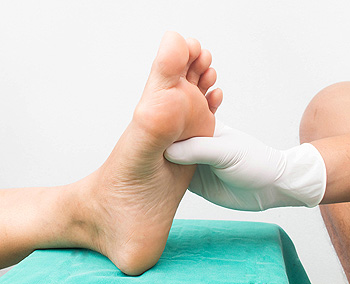 Peripheral neuropathy is a disorder that causes a malfunction in the nerves that send signals from the rest of your body to the brain and spinal cord. Symptoms of peripheral neuropathy include a sharp, stabbing pain and numbness or weakness in the feet. You may feel a tingling sensation in the feet, a buzzing or shock, or a sensation similar to wearing a tight sock. Peripheral neuropathy can also cause symptoms throughout the whole body, such as thinning of the skin, a drop in blood pressure, digestive problems, and excessive sweating. If you are experiencing the symptoms of peripheral neuropathy, it is recommended that you see a podiatrist for treatment.
Peripheral neuropathy is a disorder that causes a malfunction in the nerves that send signals from the rest of your body to the brain and spinal cord. Symptoms of peripheral neuropathy include a sharp, stabbing pain and numbness or weakness in the feet. You may feel a tingling sensation in the feet, a buzzing or shock, or a sensation similar to wearing a tight sock. Peripheral neuropathy can also cause symptoms throughout the whole body, such as thinning of the skin, a drop in blood pressure, digestive problems, and excessive sweating. If you are experiencing the symptoms of peripheral neuropathy, it is recommended that you see a podiatrist for treatment.
Neuropathy
Neuropathy can be a potentially serious condition, especially if it is left undiagnosed. If you have any concerns that you may be experiencing nerve loss in your feet, consult with one of our podiatrists from New Tampa Foot & Ankle. Our doctors will assess your condition and provide you with quality foot and ankle treatment for neuropathy.
What Is Neuropathy?
Neuropathy is a condition that leads to damage to the nerves in the body. Peripheral neuropathy, or neuropathy that affects your peripheral nervous system, usually occurs in the feet. Neuropathy can be triggered by a number of different causes. Such causes include diabetes, infections, cancers, disorders, and toxic substances.
Symptoms of Neuropathy Include:
- Numbness
- Sensation loss
- Prickling and tingling sensations
- Throbbing, freezing, burning pains
- Muscle weakness
Those with diabetes are at serious risk due to being unable to feel an ulcer on their feet. Diabetics usually also suffer from poor blood circulation. This can lead to the wound not healing, infections occurring, and the limb may have to be amputated.
Treatment
To treat neuropathy in the foot, podiatrists will first diagnose the cause of the neuropathy. Figuring out the underlying cause of the neuropathy will allow the podiatrist to prescribe the best treatment, whether it be caused by diabetes, toxic substance exposure, infection, etc. If the nerve has not died, then it’s possible that sensation may be able to return to the foot.
Pain medication may be issued for pain. Electrical nerve stimulation can be used to stimulate nerves. If the neuropathy is caused from pressure on the nerves, then surgery may be necessary.
If you have any questions, please feel free to contact our office located in Wesley Chapel, FL . We offer the newest diagnostic and treatment technologies for all your foot care needs.
Signs and Symptoms of Athlete's Foot
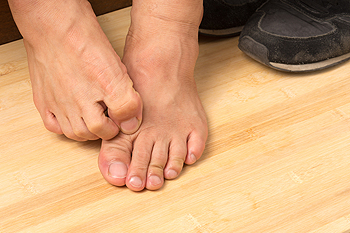 Tinea pedis, or athlete’s foot, as it is more often called, is a fungal infection of the skin on the feet. There are many symptoms of this very common condition, and it’s important to be aware of them so that you can identify a potential fungal infection early and begin treatment. Itching, stinging, or burning on the soles of your feet and between your toes, as well as dry, cracking and peeling skin, are often the most recognizable signs of athlete’s foot. You may also have itchy foot blisters or raw skin on your feet. Your toenails can also get infected and may pull away from the nail bed or become discolored, thick, and crumbly. If you suspect that you have athlete’s foot, make sure that you see a podiatrist for diagnosis and treatment.
Tinea pedis, or athlete’s foot, as it is more often called, is a fungal infection of the skin on the feet. There are many symptoms of this very common condition, and it’s important to be aware of them so that you can identify a potential fungal infection early and begin treatment. Itching, stinging, or burning on the soles of your feet and between your toes, as well as dry, cracking and peeling skin, are often the most recognizable signs of athlete’s foot. You may also have itchy foot blisters or raw skin on your feet. Your toenails can also get infected and may pull away from the nail bed or become discolored, thick, and crumbly. If you suspect that you have athlete’s foot, make sure that you see a podiatrist for diagnosis and treatment.
Athlete’s foot is an inconvenient condition that can be easily reduced with the proper treatment. If you have any concerns about your feet and ankles, contact one of our podiatrists from New Tampa Foot & Ankle. Our doctors will treat your foot and ankle needs.
Athlete’s Foot: The Sole Story
Athlete's foot, also known as tinea pedis, can be an extremely contagious foot infection. It is commonly contracted in public changing areas and bathrooms, dormitory style living quarters, around locker rooms and public swimming pools, or anywhere your feet often come into contact with other people.
Solutions to Combat Athlete’s Foot
- Hydrate your feet by using lotion
- Exfoliate
- Buff off nails
- Use of anti-fungal products
- Examine your feet and visit your doctor if any suspicious blisters or cuts develop
Athlete’s foot can cause many irritating symptoms such as dry and flaking skin, itching, and redness. Some more severe symptoms can include bleeding and cracked skin, intense itching and burning, and even pain when walking. In the worst cases, Athlete’s foot can cause blistering as well. Speak to your podiatrist for a better understanding of the different causes of Athlete’s foot, as well as help in determining which treatment options are best for you.
If you have any questions please feel free to contact our office located in Wesley Chapel, FL . We offer the newest diagnostic and treatment technologies for all your foot and ankle needs.
How to Deal with Athlete's Foot
Athlete’s foot is a type of fungal infection that affects the skin on the feet. It is caused when the tinea fungus grows on the foot. It is possible to catch the fungus through direct contact with someone who has it or by touching a surface that is contaminated with it. This type of fungus thrives in warm, moist environments such as showers, locker room floors, and swimming pools. Your risk of getting it may also increase by wearing tight-fitting, closed-toe shoes, or by having sweaty feet.
Symptoms of athlete’s foot include itching, stinging or burning sensations between the toes. You may also experience toenails that are discolored, thick, crumbly, or toenails that pull away from the nail bed.
Your podiatrist may diagnose athlete’s foot by detecting these symptoms or by doing a skin test to see if there is a fungal infection present. The most common exam used to detect Athlete’s foot is a skin lesion potassium hydroxide exam. To use this method, your doctor will scrape off a small area of the infected skin and place it into potassium hydroxide. The potassium hydroxide will destroy the normal cells and leave the fungal cells untouched so that they are visible under a microscope.
There are a variety of treatment options for athlete’s foot. Some medications are miconazole (Desenex), terbinafine (Lamisil AT), clotrimazole (Lotrimin AF), butenafine (Lotrimin Ultra), and tolnaftate (Tinactin). While these options may be able to treat your fungus, it is best that you consult with a podiatrist in order to see which treatment option may work best for you.
In some cases, Athlete’s foot may lead to complications. A severe complication would be a secondary bacterial infection which may cause your foot to become swollen, painful, and hot.
There are ways that you can prevent athlete’s foot. Washing your feet with soap and water each day and drying them thoroughly is an effective way to prevent infections. You also shouldn’t share socks, shoes, or towels with other people. It is crucial that you wear shower sandals in public showers, around swimming pools, and in other public places. Additionally, you should make sure you wear shoes that can breathe and change your socks when your feet become sweaty. If you suspect that you have Athlete’s foot, you should seek help from a podiatrist as soon as possible.
Should I Gradually Increase My Running Mileage?
The warm months of the year may encourage people to pursue the sport of running. This is considered to be a popular hobby, and methods can be implemented that may help to prevent running injuries from occurring. These can consist of wearing shoes that fit correctly, alternating between running and walking, and gradually increasing the mileage that is run each week. Research has indicated that it is best to let your feet rest between runs, and drinking plenty of water may help to increase hydration. There are numerous injuries that can happen to the feet while running, and it is suggested to consult with a podiatrist for additional ways on how to prevent running injuries.
All runners should take extra precaution when trying to avoid injury. If you have any concerns about your feet, contact one of our podiatrists of New Tampa Foot & Ankle. Our doctors will treat your foot and ankle needs.
How to Prevent Running Injuries
There are a lot of mistakes a runner can make prior to a workout that can induce injury. A lot of athletes tend to overstretch before running, instead of saving those workouts for a post-run routine. Deep lunges and hand-to-toe hamstring pulls should be performed after a workout instead of during a warmup. Another common mistake is jumping into an intense routine before your body is physically prepared for it. You should try to ease your way into long-distance running instead of forcing yourself to rush into it.
More Tips for Preventing Injury
- Incorporate Strength Training into Workouts - This will help improve the body’s overall athleticism
- Improve and Maintain Your Flexibility – Stretching everyday will help improve overall performance
- “Warm Up” Before Running and “Cool Down” Afterward – A warm up of 5-10 minutes helps get rid of lactic acid in the muscles and prevents delayed muscle soreness
- Cross-Training is Crucial
- Wear Proper Running Shoes
- Have a Formal Gait Analysis – Poor biomechanics can easily cause injury
If you have any questions, please feel free to contact our office located in Wesley Chapel, FL . We offer the newest diagnostic and treatment technologies for all your foot care needs.
Why Are Diabetics More Susceptible to Foot Wounds?
 Foot wounds or foot ulcers can become serious issues for diabetics. About 15% of people with diabetes will develop wounds on their feet. These wounds may be difficult to detect and are typically slow to heal. Many diabetics suffer from peripheral neuropathy, a loss of sensation in the lower limbs. This loss of sensation makes it hard to know if you have injured your foot. A cut, scrape, sore, or a more serious injury like a burn or puncture, can go undetected. The lack of awareness of the injury can be a big problem because diabetics also frequently suffer from poor circulation to the lower limbs. Poor circulation leads to slower healing and can make you more prone to infection. If you have diabetes, it is important to inspect your feet for wounds daily and to get treatment for your wounds as soon as possible. A podiatrist can help you care for your feet and offer treatment and prevention strategies that will work for you.
Foot wounds or foot ulcers can become serious issues for diabetics. About 15% of people with diabetes will develop wounds on their feet. These wounds may be difficult to detect and are typically slow to heal. Many diabetics suffer from peripheral neuropathy, a loss of sensation in the lower limbs. This loss of sensation makes it hard to know if you have injured your foot. A cut, scrape, sore, or a more serious injury like a burn or puncture, can go undetected. The lack of awareness of the injury can be a big problem because diabetics also frequently suffer from poor circulation to the lower limbs. Poor circulation leads to slower healing and can make you more prone to infection. If you have diabetes, it is important to inspect your feet for wounds daily and to get treatment for your wounds as soon as possible. A podiatrist can help you care for your feet and offer treatment and prevention strategies that will work for you.
Wound care is an important part in dealing with diabetes. If you have diabetes and a foot wound or would like more information about wound care for diabetics, consult with one of our podiatrists from New Tampa Foot & Ankle. Our doctors will assess your condition and provide you with quality foot and ankle treatment.
What Is Wound Care?
Wound care is the practice of taking proper care of a wound. This can range from the smallest to the largest of wounds. While everyone can benefit from proper wound care, it is much more important for diabetics. Diabetics often suffer from poor blood circulation which causes wounds to heal much slower than they would in a non-diabetic.
What Is the Importance of Wound Care?
While it may not seem apparent with small ulcers on the foot, for diabetics, any size ulcer can become infected. Diabetics often also suffer from neuropathy, or nerve loss. This means they might not even feel when they have an ulcer on their foot. If the wound becomes severely infected, amputation may be necessary. Therefore, it is of the upmost importance to properly care for any and all foot wounds.
How to Care for Wounds
The best way to care for foot wounds is to prevent them. For diabetics, this means daily inspections of the feet for any signs of abnormalities or ulcers. It is also recommended to see a podiatrist several times a year for a foot inspection. If you do have an ulcer, run the wound under water to clear dirt from the wound; then apply antibiotic ointment to the wound and cover with a bandage. Bandages should be changed daily and keeping pressure off the wound is smart. It is advised to see a podiatrist, who can keep an eye on it.
If you have any questions, please feel free to contact our office located in Wesley Chapel, FL . We offer the newest diagnostic and treatment technologies for all your foot care needs.
All About Ankle Pain
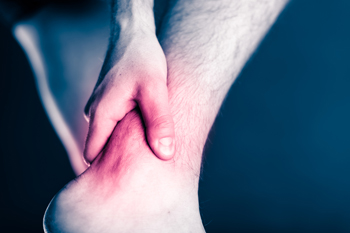 Whether you’ve rolled your ankle while walking, endured a sprain, or experience symptoms in your joints, ankle pain is something that is worth monitoring. Pain in this area can be the result of inflammation or damage to the bones, joints, cartilage, ligaments, tendons, or muscles that make up the ankle. Ankle pain is often accompanied by other symptoms such as swelling, bruising, redness, numbness, tingling, instability, and a reduced ability to bear weight on the affected ankle. The most common cause of ankle pain is an injury, such as a sprain or Achilles tendonitis. Arthritic conditions such as rheumatoid arthritis, osteoarthritis, and gout tend to cause pain in the ankle joint as well. Nerve damage or neuropathy can cause lower limb pain and is especially common among diabetics. If you are experiencing ankle pain, it is strongly recommended that you seek the care of a podiatrist, who can diagnose and treat your condition.
Whether you’ve rolled your ankle while walking, endured a sprain, or experience symptoms in your joints, ankle pain is something that is worth monitoring. Pain in this area can be the result of inflammation or damage to the bones, joints, cartilage, ligaments, tendons, or muscles that make up the ankle. Ankle pain is often accompanied by other symptoms such as swelling, bruising, redness, numbness, tingling, instability, and a reduced ability to bear weight on the affected ankle. The most common cause of ankle pain is an injury, such as a sprain or Achilles tendonitis. Arthritic conditions such as rheumatoid arthritis, osteoarthritis, and gout tend to cause pain in the ankle joint as well. Nerve damage or neuropathy can cause lower limb pain and is especially common among diabetics. If you are experiencing ankle pain, it is strongly recommended that you seek the care of a podiatrist, who can diagnose and treat your condition.
Ankle pain can be caused by a number of problems and may be potentially serious. If you have ankle pain, consult with one of our podiatrists from New Tampa Foot & Ankle. Our doctors will assess your condition and provide you with quality foot and ankle treatment.
Ankle pain is any condition that causes pain in the ankle. Due to the fact that the ankle consists of tendons, muscles, bones, and ligaments, ankle pain can come from a number of different conditions.
Causes
The most common causes of ankle pain include:
- Types of arthritis (rheumatoid, osteoarthritis, and gout)
- Ankle sprains
- Broken ankles
- Achilles tendinitis
- Achilles tendon rupture
- Stress fractures
- Bursitis
- Tarsal tunnel syndrome
- Plantar fasciitis
Symptoms
Symptoms of ankle injury vary based upon the condition. Pain may include general pain and discomfort, swelling, aching, redness, bruising, burning or stabbing sensations, and/or loss of sensation.
Diagnosis
Due to the wide variety of potential causes of ankle pain, podiatrists will utilize a number of different methods to properly diagnose ankle pain. This can include asking for personal and family medical histories and of any recent injuries. Further diagnosis may include sensation tests, a physical examination, and potentially x-rays or other imaging tests.
Treatment
Just as the range of causes varies widely, so do treatments. Some more common treatments are rest, ice packs, keeping pressure off the foot, orthotics and braces, medication for inflammation and pain, and surgery.
If you have any questions, please feel free to contact our office located in Wesley Chapel, FL . We offer the newest diagnostic and treatment technologies for all your foot care needs.
Finding the Right Shoes for Your Child
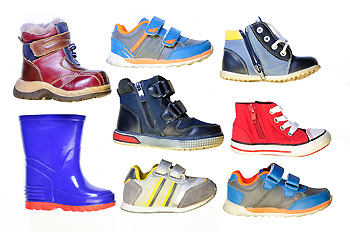 With how quickly children's feet tend to grow, shoe shopping for your little one can be a challenge. When purchasing shoes for your child, the first thing you will want to do is make sure that they are the right size! Children’s feet grow and change rapidly, so it is suggested that you take your child to the shoe store for a professional shoe fitting at least once per year rather than shopping online. A shoe store employee can also recommend shoe brands that will best fit your child’s feet specific to their needs. You will want to pick out shoes that are comfortable and supportive, and that leave wiggle room for their toes. For more information on finding proper-fitting shoes for your child, consult with a podiatrist.
With how quickly children's feet tend to grow, shoe shopping for your little one can be a challenge. When purchasing shoes for your child, the first thing you will want to do is make sure that they are the right size! Children’s feet grow and change rapidly, so it is suggested that you take your child to the shoe store for a professional shoe fitting at least once per year rather than shopping online. A shoe store employee can also recommend shoe brands that will best fit your child’s feet specific to their needs. You will want to pick out shoes that are comfortable and supportive, and that leave wiggle room for their toes. For more information on finding proper-fitting shoes for your child, consult with a podiatrist.
It is important to find shoes that fit you properly in order to avoid a variety of different foot problems. For more information about treatment, contact one of our podiatrists from New Tampa Foot & Ankle. Our doctors will treat your foot and ankle needs.
Proper Shoe Fitting
Shoes have many different functions. They cushion our body weight, protect our feet, and allow us to safely play sports. You should always make sure that the shoes you wear fit you properly in order to avoid injuries and deformities such as: bunions, corns, calluses, hammertoes, plantar fasciitis, stress fractures, and more. It is important to note that although a certain pair of shoes might be a great fit for someone else, that doesn’t mean they will be a great fit for you. This is why you should always try on shoes before buying them to make sure they are worth the investment. Typically, shoes need to be replaced ever six months to one year of regular use.
Tips for Proper Shoe Fitting
- Select a shoe that is shaped like your foot
- Don’t buy shoes that fit too tight, expecting them to stretch to fit
- Make sure there is enough space (3/8” to ½”) for your longest toe at the end of each shoe when you are standing up
- Walk in the shoes to make sure they fit and feel right
- Don’t select shoes by the size marked inside the shoe, but by how the shoe fits your foot
The shoes you buy should always feel as good as they look. Shoes that fit properly will last longer, feel better, and improve your way of life each day.
If you have any questions, please feel free to contact our office located in Wesley Chapel, FL . We offer the newest diagnostic and treatment technologies for all your foot care needs.

